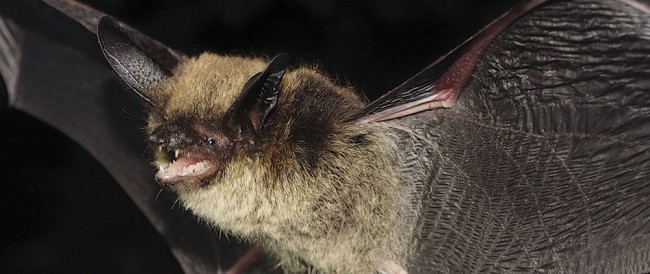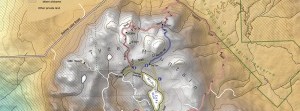
Photo Credit: Christian Engelstoft
Bats in Winter: Volunteers help monitor sub-zero flying mammals
The wind blowing down the Skeena River is strong and cold. Nelson-based bat expert Cori Lausen carefully adjusts the leads to the 12-volt battery. “If the light is green,” she says, “the solar panels are working and the battery is charging. If the light is red, you need to change it.”
I mentally think ahead to January. Unlocking the equipment box with bare, freezing fingers, then attaching cables to the data loggers would be a bit challenging, but, if bats can be out flying in the middle of winter, we should at least be able to keep Lausen’s equipment working.
Recording bat calls in the dead of winter seems to be one of those research projects that causes people to roll their eyes and talk about wasting public money. Lausen’s research is none of this. On the leading edge of documenting where bat species are located in BC, she is also a key Canadian researcher studying white-nose syndrome (WNS), an introduced European fungal disease that has killed thousands of bats in eastern Canada. Lausen’s winter bat call program is an important tool in determining normal bat activity in British Columbia before this deadly disease hits the province.
Little is known about bats in northern BC. Many are not even aware that we have bats this far north. There are 17 different species in BC of which nine are limited to the South. Of the remaining eight, the northern bat is found mostly on the far eastern side of BC’s North and the rare Keen’s bat is found only along the coast and coastal inland valleys, along with the more common California bat. The most common northern species are the little brown bat and the silver-haired bat, which both occur widely throughout North America. Three other northern bat species—the big brown, long-eared and long-legged bats—have small populations throughout their provincial ranges.
Lausen’s specialized equipment records the ultrasonic calls that bats make when they are pursuing insect prey or flying between locations. Each species has a signature echolocation voicing, which allows her to identify the calls picked up by her sensors. By using solar panels to recharge a battery powering the data recorders, she is able to leave the recorders for days at a time in remote locations. Combined with netting programs, Lausen and her research associates are expanding the province’s scientific information on where and when bat species occur in northern BC.
Insect control
The wind is blowing so strongly we are surrounded by a shower of autumn leaves. A pair of hikers doing the circuit passes: “Hi, Elaine,” I shout cheerfully. Elaine and her friend stop, starting a lively discussion about the monitoring program and where to find local bats.
The majority of reports about bat activity in the Terrace area come from people living at Lakelse Lake to the south. They range from sightings of large numbers hunting insects over water in late evening to a maternity colony of little brown bats under the shingles of someone’s cabin. When Lausen and her research partner netted bats next to the Lakelse River this summer, they detected both little brown bats and Yuma bats in significant numbers.
The Lakelse area is a rich location for bats, but there is also a surprising number throughout most of northern BC. Seeing them is a matter of timing and location. The majority of species belong to the evening bat family; therefore, northern bats are most active just before dawn and in the late evening or early night. They like to feed on insects that fly over water or open areas. A steep cliff face, river, wetlands, lake or even a wide, warm road just at dusk can be a good location to watch them.
Bats are important predators of flying insects. It is estimated that a single little brown bat will eat in the range of 900 insects an hour. During a recent monitoring session in the Nass Valley, 1,200 separate calls from four different bat species were recorded over a single night. With each bat consuming in the range of 4,000 bugs a night, the volume of prey consumed by northern bats can be a significant factor in controlling biting insects.
Mysteries of winter
Although the summer habits of northern bats are reasonably well understood, there is a dearth of winter bat knowledge. Very little is known about what species do and where they go during cooler months. Recording bat calls cannot only help to determine if they are out and moving in winter, it can also address such questions as whether bats are moving up and down the Skeena River valley at certain times of the year, if there are waves of migrating bats in the fall passing south through the northern interior or if the majority of bats are hibernating close to summer habitat.
Understanding the winter ecology of northern bats might also be essential for their long-term survival. In Eastern Canada, winter bat movement has been strongly associated with white-nose syndrome. The extensive, itchy growth of fungi on the bats’s skin is assumed to rouse them out of hibernation, causing them to fly out into the cold winter air to their deaths. In Western Canada, where WNS has not yet been found, Lausen’s work in Alberta and BC has shown that some bats naturally awake in winter and leave their hibernacula to fly about at temperatures as low as -8 C. The causes for these flights are not known, although suggestions have been made that dehydration or disturbance or some physiological need to move may be driving the bats to leave the warmth and security of their colonies.
Of the eight known northern bat species, little brown bats have been assumed to migrate south, although some individuals or small colonies might be hibernating in spots below the frost line, such as in deep rock cracks of cliffs, caves or abandoned mines. Other species, such as the long-legged bat and the long-eared bat, can also hibernate in caves, rock crevices or mines, but the silver-haired bat most commonly hibernates under bark or in holes on large trees, moving to rock crevices and mines during extremely cold weather events. Others, such as the big brown bat, may be hibernating in old buildings. Disturbance in winter can cause these bats to be active in sub-zero temperatures.
No one knows for certain where northern bats go in winter. Lausen’s research will help find answers to this important question. Call recorders have been placed across the Highway 16 corridor from Vanderhoof to Prince Rupert and north to the Nass Valley. Volunteers will watch over the equipment throughout the winter, changing batteries and data cards when necessary and ensuring that the equipment and solar panels stay upright despite storms, moose and flooding. When the data is gathered next spring and scanned for bat calls, some answers to intriguing questions will emerge.
As Elaine and her friend continue on their walk, Lausen checks the chain linking the equipment box and solar panels. “Most people want us to know more about bats,” she says. “Let’s hope this works.”
If you see a bat during winter or find a winter bat hibernaculum, please contact Cori Lausen at clausen@wcs.org






